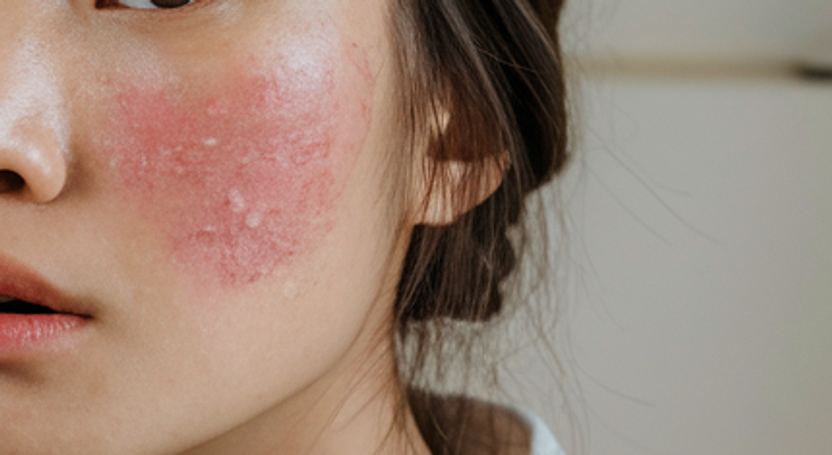Understanding Rosacea: Causes, Symptoms, and Tips for Managing Sensitive Skin
By:
Kevin Chong
On
11/01/2024Reading time:
5 min
Summary:
Rosacea is a chronic skin condition that affects millions of people worldwide, often causing redness, visible blood vessels, and even acne-like breakouts on the face. Although its exact cause is unknown, rosacea is known to worsen with certain triggers, making it challenging to manage. But with the right skincare routine and lifestyle adjustments, people with rosacea can reduce symptoms and maintain a calmer complexion.
In this post, we’ll explore what rosacea is, common symptoms, potential causes, and tips to help manage and soothe rosacea-prone skin.

What Is Rosacea?
Rosacea is a chronic inflammatory skin condition that primarily affects the face. It usually appears on the cheeks, nose, forehead, and chin, causing redness, visible blood vessels, and in some cases, small pus-filled bumps that resemble acne. It’s more common in adults, especially those with fair skin, though it can affect individuals of any skin tone.
Key Symptoms of Rosacea:
Persistent Redness: Redness is usually concentrated in the center of the face and can spread over time.
Visible Blood Vessels: Small, dilated blood vessels (known as telangiectasia) may become visible, especially on the nose and cheeks.
Acne-Like Bumps: Rosacea can cause red bumps or pimples, often mistaken for acne.
Thickened Skin: Over time, untreated rosacea may lead to thickened skin, particularly on the nose (a condition known as rhinophyma).
Eye Irritation: Some individuals experience rosacea in and around the eyes, causing redness, irritation, or swollen eyelids (ocular rosacea).
Common Triggers and Causes
While the exact cause of rosacea remains unknown, a combination of genetic, environmental, and lifestyle factors can contribute to flare-ups. Here are some common triggers:
1. Environmental Triggers
Extreme temperatures, sun exposure, wind, and humidity can all aggravate rosacea symptoms. UV radiation is particularly problematic, as it can inflame already sensitive skin.
2. Lifestyle and Dietary Triggers
Foods and drinks that increase blood flow, such as spicy foods, alcohol, and hot beverages, can trigger rosacea symptoms. Exercise, stress, and certain skincare products with harsh chemicals are also known to contribute to flare-ups.
3. Skin Microbiome and Demodex Mites
Research has suggested that people with rosacea may have a higher density of Demodex mites, tiny mites that naturally live on human skin. An overgrowth of these mites may trigger an immune response that leads to rosacea symptoms.
4. Genetics
Rosacea often runs in families, indicating a possible genetic predisposition. Individuals with fair skin and a family history of rosacea may be at a higher risk.
Tips for Managing Rosacea
Although rosacea has no cure, adopting a gentle skincare routine and avoiding known triggers can help manage symptoms effectively. Here are some tips to care for rosacea-prone skin:
1. Use a Gentle Cleanser
Opt for a non-foaming, fragrance-free cleanser to avoid irritation. Avoid harsh exfoliants or scrubs, as these can aggravate redness and inflammation.
2. Choose a Moisturizer for Sensitive Skin
Keeping the skin hydrated is essential, as dry skin can make rosacea symptoms worse. Look for moisturizers labeled for sensitive skin, preferably those with calming ingredients like aloe vera, niacinamide, or ceramides. Avoid products with alcohol, menthol, or other drying agents.
3. Incorporate Sun Protection
Since UV exposure can worsen rosacea, daily sunscreen is a must. Choose a mineral sunscreen (with zinc oxide or titanium dioxide) that’s gentle on sensitive skin. Many people with rosacea find that mineral sunscreens cause less irritation than chemical ones.
4. Avoid Known Triggers
Identify personal triggers by keeping a symptom diary and tracking foods, beverages, activities, and skincare products. Once you know your triggers, avoiding them can significantly reduce flare-ups.
5. Try Calming Ingredients
Skincare ingredients like green tea extract, licorice root, chamomile, and colloidal oatmeal are known for their calming properties and can help reduce redness and soothe inflamed skin. Products containing azelaic acid can also be beneficial for treating bumps and redness, as it has anti-inflammatory properties.
6. Consider Professional Treatment
If rosacea symptoms are severe or persistent, consult a dermatologist. Prescription treatments like topical antibiotics, oral medications, and laser therapy can provide relief for many people. Dermatologists can also recommend advanced treatments such as intense pulsed light (IPL), which helps reduce visible blood vessels and redness.
Common Myths About Rosacea
There are several misconceptions about rosacea that can make it difficult for individuals to understand and manage their condition. Here are a few common myths:
Myth: Rosacea is just a form of acne.
Fact: Although rosacea can cause acne-like bumps, it is a distinct inflammatory condition with different underlying causes and requires a different treatment approach than acne.Myth: Only people with fair skin get rosacea.
Fact: Rosacea is more common in individuals with fair skin but can affect people of all skin tones and ethnicities. The symptoms might look different on darker skin tones, making diagnosis challenging.Myth: Rosacea only affects the skin.
Fact: Rosacea can affect the eyes (ocular rosacea), leading to redness, irritation, and sometimes vision problems.
While rosacea can be challenging to manage, a gentle skincare routine, sun protection, and avoiding triggers can help keep symptoms under control. Each person’s experience with rosacea is unique, so finding a personalized approach is key. For those with persistent symptoms, seeking professional treatment can offer additional relief and help improve quality of life.
By understanding what works best for your skin and adopting a calm, supportive routine, it’s possible to keep rosacea flare-ups to a minimum and maintain a healthy, comfortable complexion.
